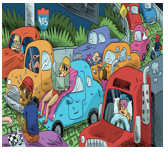Date: Mar 6, 2015
This past May the project known as the I-405 Sepulveda Pass Improvement Project came to official completion, with resulting new on-ramps and off-ramps, bridges and a northbound 405 carpool lane stretching 10 miles between the 10 and 101 Freeways.
The four-turned–five-year, $1.1 billion project became a long-running nightmare of sudden ramp closures, poorly advertised by Metro and made all the worse by baffling detours that led drivers into the unfamiliar Bel Air Hills and Sherman Oaks hills, dead ends and unlit canyons.
As Metro's closures and delays reached their height in 2013, LA Weekly encountered stranded motorists merely by following Metro's official detours — which in many cases were roads to nowhere. And it isn't over in the Valley or on the Westside. Sudden ramp and lane closures are still hitting motorists at Getty Center, Valley Vista, Skirball Center and elsewhere as work on the officially completed project grinds on.
 There is one crystal-clear improvement: With barricades gone and ramp closures less frequent, commuters are at least getting relief from problems Metro itself created — particularly its widely mocked detours, which proved indecipherable on its website and could not be explained by road crews. Now, says Brian Taylor, director of UCLA's Institute of Transportation Studies, commuters who had to leave home "at 5:15 a.m." during the five-year rebuilding are "leaving at 7."
There is one crystal-clear improvement: With barricades gone and ramp closures less frequent, commuters are at least getting relief from problems Metro itself created — particularly its widely mocked detours, which proved indecipherable on its website and could not be explained by road crews. Now, says Brian Taylor, director of UCLA's Institute of Transportation Studies, commuters who had to leave home "at 5:15 a.m." during the five-year rebuilding are "leaving at 7."
But the $1.1 billion question hangs in the air: Is the 405 any more relieved of congestion than when Mayor Antonio Villaraigosa, Congressman Brad Sherman and County Supervisor Gloria Molina demanded in 2006 that LA's "fair share" of state bond money be used to add carpool lanes to the 405?
The answer is no.
(Read the rest)
-cw
Graphic credit: Jimmy Giegerich
CityWatch
Vol 13 Issue 19
Pub: Mar 6, 2015
{module [1177]}




